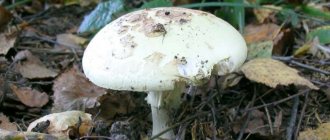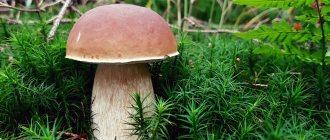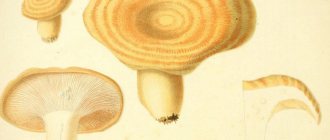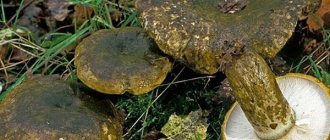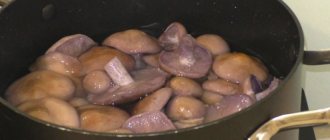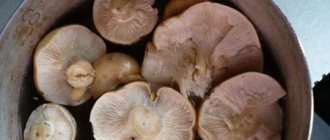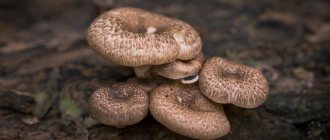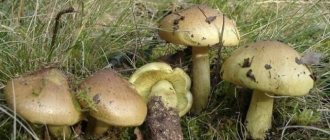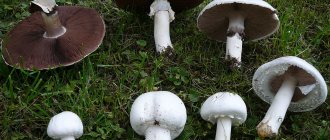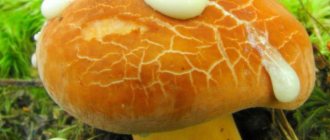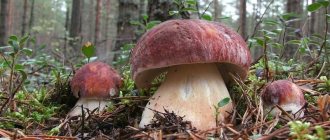“Silent hunting”, starting in the second half of summer (and often earlier), draws crowds of mushroom pickers into the forests. Some already know secret paths and “bread” places, others have just begun to master the subtle science of searching for prey. And such people can easily be misled by molokanka - a mushroom similar in appearance to white milk mushroom, but very different from it in taste. And not for the better.
Medicinal properties and uses
A number of special active substances with unique medicinal properties were found in the pulp and milky juice of the mushroom.
The spurge mushroom is widely used in folk medicine. The milky juice secreted by it is especially valued and is used as an antitumor agent. An ethanol-based extract is prepared from fresh milkweed, which is used in folk medicine as a remedy in the fight against cancer. It has been proven that the substances contained in it act as an active antioxidant and suppress the growth of cancer cells in the body.
The hormone cortisone and other steroids were found in the fruiting bodies of milkweed. This determines the scope of use of the mushroom - the production of means to combat inflammatory processes in the body and rheumatism.
Growing
You can grow the spurge mushroom at home under any tree species, but nut plantations provide maximum germination and yield. In addition, such proximity significantly increases the fruiting of crops due to the formation of mycorrhiza.
Milkweed spores can be purchased at the store and sown according to the instructions:
- Mix 15 g of seeds with 0.5 liters of sand or dry soil (per 1 m²).
- Fluff up the soil under the tree, reaching the roots, to a depth of 5–15 cm.
- Distribute the mycelium over the area.
- Cover with garden, or better yet, forest soil, mixed in equal proportions with humus.
- Use a watering can with a fine sprayer to pour 10 liters of water per m².
- Mulch the top with soil and sawdust.
Did you know? Almost two thirds of mushrooms sold on the world market are artificially grown in China.
You can obtain seed material yourself. To do this, you need to find old mushrooms without washing them, grind them in a meat grinder, add water and leave in a dark, warm place for 2 weeks. After time, the cake on top must be removed, and the remaining liquid will be a solution of milkweed spores.
Next, everything is done in the same way as with purchased material, only the mycelium will be distributed over the area not in dry form, but by watering. A harvest of red-brown milk mushroom can be expected within three months, then fruiting, subject to proper watering, will continue until the end of October.
Classic recipe for cold pickling of milkweeds
The simplest and most convenient method of pickling mushrooms is the cold method. By preparing milkweed in this way, the housewife does not need to stand at the stove for a long time. It is enough to soak the mushrooms, lay them out in layers and leave them for several days under a heavy load. This salting method is good for saffron milk caps, which retain their taste after the procedure.
Ingredients:
- 1 kg of milkweeds;
- 2 tbsp. l. salt;
- garlic, horseradish, oak, currant leaves - to taste.
Step-by-step preparation:
- Remove dirt, wash and clean the main ingredient.
- Separate the caps and place them in a container.
- Pour water over the mushrooms, completely immersing them in the liquid.
- Set the oppression and maintain it for a day.
- Drain the solution, remove the caps and rinse under water.
- Place the leaves in an enamel container, and then a layer of caps.
- Alternate the layers of “mushrooms - salt” as long as the dimensions of the container allow.
- Place the greens on top in a dense layer, cover with gauze, create pressure and put the container in a cool place for a certain time.
- After a set time, the milkweed can be transferred to jars, closed with lids and stored in the basement or on the balcony.
In order to understand how long to keep mushrooms under pressure, it is worth understanding their type. Milk mushrooms require 30 days of being under oppression, and saffron milk caps require 5 days. After the period has expired, the pickles can be safely served.
Volnushki should be under load for about 40 days
Similar species and how to distinguish them from them
Rarely encountered by mushroom pickers, the red-brown milk mushroom is not so easily confused with other species of the mushroom kingdom. An inexperienced mushroom picker may look around and mistake the inedible gray-pink milkweed (Lactarius helvus) for the hero of the article, but these mushrooms are easy to distinguish without detecting a large amount of white juice and a characteristic smell (gray-pink smells like dry grass). And his hat is much paler.
The edible hygrophoroid milkweed (Lactarius hygrophoroides) differs from the common rubber plant in its milky juice that does not change color and its sparsely spaced plates. And the conditionally edible non-caustic milkweed (Lactarius mitissimus) is smaller in size, the skin on the cap is not covered with cracks.
Interestingly, from a distance, spurge can be confused with common camelina (Lactarius deliciosus). Also similar to it is the neutral milkweed (Lactarius quietus), a conditionally edible mushroom, distinguished by its yellowish milky juice and lack of fishy odor.
Molokanka is a mushroom similar to a milk mushroom. Cooking molokan mushrooms
“Silent hunting”, starting in the second half of summer (and often earlier), draws crowds of mushroom pickers into the forests. Some already know secret paths and “bread” places, others have just begun to master the subtle science of searching for prey. And such people can easily be misled by molokanka - a mushroom similar in appearance to white milk mushroom, but very different from it in taste. And not for the better.
Possible harm and complications
Before you start treatment with euphorbia, you need to find out about contraindications and possible harm of the product. Mushroom tincture should not be used by children, as well as women who are carrying or breastfeeding a child. Smooth contains highly active substances for which the body must be prepared.
If you are intolerant to these components, the following problems may occur:
- skin itching;
- gastrointestinal disorder;
- allergic rhinitis and ARVI;
- atopic dermatitis;
- a sharp increase in temperature;
- headache;
- cough, shortness of breath.
It is not recommended to include mushrooms in your diet for people suffering from kidney and liver pathologies, gastritis or cholelithiasis. It is recommended to use this product 3 hours before bedtime. If you have regular high blood pressure, it is worth reducing the amount of dairy milk consumed, as they contain a fairly large amount of water. Abuse of mushrooms can lead to heartburn, nausea, abdominal pain, and gastrointestinal disorders, so you need to know moderation in everything.
If you meet this rare guest in the forest, you should not pass by. You can put milkweed in your basket and use it in combination with other lamellar mushrooms. After all, this mushroom is never wormy
It is important to remember that too many fried and pickled mushrooms can be harmful to health, even if a person has no contraindications
Red-brown breast milk (Lactarius volemus)
Synonyms:
- Galorrheus volumemus
- Lactifluus volumemus
- Amanita lactiflua
- Lactarius lactifluus
- Lactifluus oedematopus
- Lactarius oedematopus
- Lactarius ichoratus
- Galorrheus ichoratus
- Lactifluus ichoratus
- Lactarius testaceus
- Mlechnik is the best (by the way, the official Russian-language mycological name)
- Podoreshnik (Belarusian – Padareshnik)
Lactarius volumemus (Fr.) Fr., Epicr. syst. mycol. (Upsaliae): 344 (1838)
Description
The cap is 5-17 (up to 16) cm in diameter, convex in youth, then spread out, possibly depressed in the center, and even concave. The edge of the cap is straight, thin, sharp, at first tucked in, then straightens and even rises. The color is reddish-brown, brownish-brown, in rare cases rusty or light ocher. The surface is first velvety, then smooth and dry. Often cracked, especially in drought. There is no zonal coloration.
Pulp: White, yellowish, very fleshy and dense. The smell is described in various ways, mainly as a herring (trimethylamine) smell that increases with age, but there are also more interesting associations, for example with pear flowers, or not specified at all. The taste is soft, pleasant, sweetish.
The plates are frequent, from adherent to slightly descending, cream or warm skin tones, often forked at the stem. There are shortened plates (lamellae).
The milky juice is abundant, white, turning brown and thickening in air. For this reason, in this type of milkweed, everything else turns brown when damaged - the pulp, the plates.
Leg 5-8 (up to 10) cm high, diameter (1) 1.5-3 cm, hard, often cap-colored, but slightly paler, smooth, may be covered with fine pubescence, which looks like frost, but not to the touch is felt. Often narrowed towards the bottom.
The spore powder is white. The spores are close to spherical, according to 8.5–9 x 8 µm, 9-11 x 8.5-10.5 µm. The ornamentation is ridge-shaped, up to 0.5 microns high, forming an almost complete network.
Habitat
Found from July to October. One of the earliest lacticians. Grows in deciduous, mixed and spruce forests (in general, in all forests). According to the data, it forms mycorrhiza with oak (Quercus L.), common hazel (Corylus avellana L.) and spruce (Picea A. Dietr.).
Similar species
Considering the “power” of this mushroom and the abundant brownish sweetish milky juice, perhaps it has no similar species. The most similar lactifer to it is, perhaps, the hygrophoroid milkweed - Lactarius hygrophoroides, but it is easily distinguished by its non-browning milky sap and sparse plates. Quite conventionally, the rubella (Lactarius subdulcis) can be classified as a similar species, but it is thin-fleshed and delicate. The same applies to the orange milkweed (Lactarius aurantiacus = L.mitissimus), it is not only small and thin, but also late, does not overlap in terms of timing, although it grows in exactly the same biotopes with spruce.
Edibility
An edible mushroom that can even be eaten raw. It is good in raw pickled or pickled form, without any heat treatment. I don’t like it in its other form because of the “wooden” pulp, although they say it makes good mushroom caviar. I hunt for it specifically and purposefully, for the sake of raw salting.
References1) Verbeken, A. & Vesterholt, J. 2008. Lactarius. – In: Knudsen, H. & Vesterholt, J. (eds.): Funga Nordica, 82-107.2) Flora of Belarus. Mushrooms. In 7 volumes. Volume 1. O.S. Gapienko, Y.A. Shaporova, 2012, Boletales. Amanitales. Russulales.
Video about the Euphorbia mushroom:
Benefits of lingonberry jam
Lingonberries also make a delicious sauce for meat.
These bright red sweet and sour berries are well known to the inhabitants of the tundra, Siberia and the Far East. After all, it is in these parts that lingonberries can be found in abundance. Residents of other regions are less fortunate, but they can always purchase it frozen. Most supermarkets offer this berry.
And before I tell you how to make jam, I want to remind you about the main properties of the berry:
- a powerful immunostimulant. Lingonberries contain such an amount of vitamin C that will help you survive any winter without colds;
- protector of the heart. With the help of berries you can fight high blood pressure;
- digestive system assistant. Lingonberries improve metabolic processes and reduce the load on the gastrointestinal tract;
- disinfectant. The presence of benzoic acid allowed the berry to fight a wide variety of infections in the body and take them along with medication for the treatment of cystitis, pyelonephritis and other diseases.
Video text
Subscribe to our group “Hryby of Ukraine” on Facebook: https://www.facebook.com/groups/Hryby. — Hello everyone, in this video I’ll tell you about Milkweed, Euphorbia, or Euphorbia, also known as Red-Brown Milkweed (Lactarius volemus). The name of this species is due to the fact that the mushroom contains a large amount of milky juice; the Latin name literally means “milky filled.” The milkweed, like all Milkweeds, forms ectomycorrhiza with various types of trees; it lives in broad-leaved, deciduous and mixed forests (with oak or hazel), less often in coniferous (spruce) forests. It bears fruit in July-October, in small groups or singly. It is widespread in the Forest-Steppe, Polesie and the Carpathian region, but is relatively rare.
The milkweed is a rather large mushroom, its cap reaches an average of 8-15 cm, sometimes up to 20 cm in diameter, at first it is convex, then becomes convex-spread, with a drooping edge, even later the edge becomes straight and the cap is spread out. The cap is very fleshy, the color is in various transitional yellow-red-brown tones, often brick shades, the surface is dry, velvety and matte, becoming covered with small cracks with age. The plates are frequent, thin, sometimes forked, adherent, or slightly descending, whitish-yellowish, later ocher-brown, turning brown when touched. The leg is up to 10 cm in length and up to 3 cm in diameter, cylindrical, smooth or swollen, the same color as the cap, or a little lighter. The milkweed is thick-fleshed, the flesh is white, turns brown in the air, with age it acquires an odor that, according to literary sources, is unpleasant, herring-like, but personally I don’t feel any fish in it, especially herring, it reminds me exactly of the smell and taste of white fibrous core of a sunflower flower basket. Mushrooms of this species rarely worm, due to the content of a very large amount of milky juice, which, when damaged, literally pours out of the mushroom and prevents the larvae from developing normally. Its milk is white, sweetish, sticky, in the air it slowly turns gray and darkens, becomes thick, viscous, then rubbery in consistency, due to the content of natural rubber polyisoprene, which is contained in dry mushrooms up to 8%, which makes it possible to use these fungi in rubber production. And here I came across completely unexpected parallels. One of the little-known features of sunflower is its rubber-bearing properties. Not long ago, breeders developed special varieties that release latex in significant quantities from cuts in the stem. Rubbers produced on its basis are very hypoallergenic in comparison with natural and synthetic rubbers. Those. the similar smell and taste of milkweed with the fibrous core of sunflower is due precisely to the rubber content of these distant species from different kingdoms.
Euphorbia mushroom (milkweed)
The mushroom is edible. The cap is very fleshy, 5-15 cm, convex, later flattened or slightly depressed, dry, not slimy when moistened, sometimes cracks, orange or brownish-orange. The plates are adherent, descending, dense, creamy. The leg is 5-12 cm long, 2-3 cm thick, dense, hollow, orange or reddish-orange. The milky juice is white, abundant, turns slightly brown in air, is not at all pungent, with a characteristic herring odor, which disappears after cooking or other heat treatment. The pulp is dense and can be easily cut with a knife.
Grows in deciduous and coniferous forests, especially along roads and paths.
How to cook
Euphorbia differs from other milkweeds in its bitter taste. After processing it becomes sweeter. It is recommended to salt or marinate the mushroom; it is also fried, dried and stewed. To do this, you need to take only young specimens that have a pleasant taste. Milkweed is classified as quality category 4. Such mushrooms are prepared by some amateurs who consider them a delicacy.
Euphorbia is more valued in the West than in Russia. However, many mushroom pickers in our country go out on a quiet hunt in the hope of meeting it on their way and prefer to eat milkweed in its raw form, that is, without pre-processing. It is better not to do this, because mushrooms are capable of accumulating harmful substances from the soil.
Before cooking, the collected mushrooms need to be boiled for 10-15 minutes. This will reduce the amount of toxins in the product, but the specific smell will not disappear. Before cold salting, you need to soak the mushrooms for 1-2 days. This should be done in a glass or enamel container, after first cleaning the mushrooms from dirt. This will help get rid of bitterness. Then the spurge is placed in a deep container and sprinkled with salt. For 3-3.5 kg of mushrooms you need 150 g of salt. The container is left in the refrigerator for 4 weeks. This salty dish is suitable for pizza, salads and as a snack.
Fried mushrooms with onions and sour cream
You can make many excellent dishes from milkweed. So, for example, to fry mushrooms with onions and sour cream, you will need:
- 800 g fresh mushrooms;
- 300 g sour cream;
- vegetable oil;
- 1 onion;
- Wheat flour;
- salt and pepper.
7 preparation steps:
- The mushrooms must be thoroughly washed and sorted, removing any debris.
- Then they need to be filled with cold water and sent to the fire, adding a pinch of salt.
- After boiling, cook the milkweed for 20 minutes, then drain the mushrooms in a colander and wait until the water has completely drained.
- Next, the boiled milk jugs are cut into cubes and fried in a frying pan with a thick bottom in heated vegetable oil.
- For a golden crust, you can bread them in flour.
- After 5 minutes, add the onion, cut into half rings, into the pan and continue cooking the food for 3-4 minutes.
- Then everything is poured with sour cream and seasoned with salt and pepper. This composition must be simmered for 10-15 minutes.
It is recommended to serve the dish hot, sprinkled with grated cheese and herbs.
Fried red-brown milk mushrooms with eggs and sour cream
This original recipe of eggs and mushrooms will surely appeal to many housewives. For it you will need:
- 6 chicken eggs;
- 250 g fried smoothies;
- 120 g hard cheese;
- salt pepper;
- 3 tbsp sour cream.
Let's prepare it like this:
It is necessary to mix mushrooms, grated cheese, pepper, salt and sour cream in a bowl, pre-fried until fully cooked. Boiled eggs are cut lengthwise into two halves and the yolk is removed from each. It can be added to the prepared mixture and ground. The resulting filling is placed in the egg halves and decorated with herbs.
It is advised to follow some rules when preparing dishes from milkweed:
- It is better to take a cleaning knife from stainless metal.
- Already prepared mushrooms need to be cooked immediately.
- Milkweed dishes are best consumed on the day of preparation.
- You can store fresh mushrooms that have not yet been processed in the refrigerator.
Milkweed is an excellent source of protein. And there is even more of it in dry mushrooms than in meat. Therefore, it is recommended to eat milkweed during the diet. Its calorie content is 65 kcal.
Direct salting
So, you have fully prepared molokan mushrooms. How to salt is a separate song, although not too difficult to perform. In the absence of a tub, it is recommended to use an enamel bucket without chips on the inner surface.
Large caps can be cut - purely for ease of use. The mushrooms are layered with halved garlic (about a head will be left), thin circles of horseradish root, lemongrass and black currant leaves, dill seeds (or its umbrellas). Black peppercorns are also acceptable, but not too much. Each layer is sprinkled with a coffee spoon of salt. The top of the bucket is covered with clean gauze, a wide plate and a weight are placed on it - a three-liter bottle of water will be enough. Monitor the condition vigilantly: if mold forms on the gauze, it must be washed. It’s better to replace it with a new one, it’s not that expensive.
Molokankas will be salted from a couple of weeks to a month, depending on the temperature. The warmer the faster, the colder the tastier. It is better to store them cool and eat them like any other salted mushrooms.
Source
Where does it grow?
If you want to find a milkweed mushroom, you can do it this way: it grows in one copy in hard-to-reach places. It can often be found in coniferous or deciduous forests. Good growth is ensured by moss and rotten stumps located near the growing season.
Sparrowwood has a very pleasant taste and is classified in the fourth quality category. They can be eaten salted or boiled. These mushrooms do not require pre-soaking. But there are some exceptions. It will be better if you eat only young mushrooms. Adults have a somewhat unpleasant odor and taste.
Preparation
With the right approach to preparing milkweed, this mushroom will amaze you with its original taste. A specific feature of milkweed is the presence of a fishy smell, which becomes more noticeable as the mushroom ages. During the cooking process, the smell becomes even more pronounced. As for the group of young mushrooms, they have a more pleasant and rich taste.
The mushroom can be pickled, stewed, fried, dried and even salted. Before pickling, it is worth soaking the spurge well. This will get rid of bacteria and give the mushrooms a special taste. It is worth noting that milkweed is never damaged by larvae, so more and more mushroom pickers like to eat it raw with salt.
If you want to process the mushrooms, the best solution is cold pickling. Rinse the red milkweed under water and place it in layers in a deep container. Each of them needs to be sprinkled with salt. For 3 kg of mushrooms you need 150 grams of salt. After this, put the container in the refrigerator for a month. After this period, you can taste the mushrooms. If they are too salty, they can be diluted with boiled water. They are perfect for salads and pizzas.
Now you know what milkweed is and what properties it has. Thistle will be useful both from a medical point of view and for simple consumption.
Recipe No. 4 (in a water bath)
- Lingonberries and sugar. Equal quantities.
- Take two pans of different sizes. Pour water into the large one and place the small one in it.
When the water in the bottom boils, pour berries and sugar into the top. Heat until the sugar dissolves and that’s it. You can eat it right away or pour it into a jar.
Improvise with the amount of sugar, replace it with honey, add various fruits, cranberries and blueberries.
Remember that it is difficult to completely spoil the jam; there is always a way out. If too sweet, add lemon juice. It will also protect the jam from sugaring.
If it becomes moldy, add a glass of sand per 1 kg of berries and digest, constantly skimming off the foam. When the foam stops appearing, turn off the gas and pour into jars.
But now we have returned from Lapland. The five jars of jam I had brought with me suddenly ran out quickly. But the strong desire to gnaw on a piece of toast with delicious sweet and sour berries in the morning or to put a spoonful of lingonberries in cottage cheese remains. The first attempts, consisting of lingonberries and sugar, were similar in taste, but in terms of thickness they categorically did not reach the Finnish ideal.
Salvation came in the form of pectin for quick jam. With him I finally managed to get it thick, beautiful, and sweet exactly as much as I want at the moment. But the recipe on the packets of this miracle remedy is very, very general, and the berries are all different, each requiring a special approach. If you don’t sell pectin, I don’t even know what to recommend. When I can’t buy pectin, I try my best to cook it with quince and apples, but it still turns out a little different.
JAM 500 g lingonberries, 200-300 g sugar, 10 g pectin (meaning, half a pack for 1 kg of berries. If you want, you can cook a whole kilo of lingonberries with a whole pack, just don’t forget that you need twice the sugar more, but that’s too much for me at one time)
Berries for lingonberry jam are equally suitable both fresh and frozen. It doesn’t hurt to sort both of them before cooking to remove pine needles, dry leaves and ant corpses, but defrosting frozen ones is completely unnecessary - they will defrost themselves during cooking.
We sorted it out and weighed it - pour it into a saucepan, sprinkle it with pectin, mix it and put it on the fire to cook. At first you will have to stir quite often, but as soon as the lower berries give juice, the jam will begin to calmly come to a boil, without the risk of burning. No need to add water! The berries will definitely give juice, and we have absolutely no need for excess liquid in the jam.
As soon as the berries boil, you need to note the time and you can add sugar. First add 200 g of sugar, stir and taste after 1 minute. Lingonberries come in different varieties, if you come across ripe and sweet ones, then maybe 200 g will be a little too much. But if it’s sour, there’s nothing you can do, you’ll have to add another 50, and then maybe another 50 g of sugar.
300 g is the maximum I’ve ever poured into lingonberry jam, but I generally like it sour. The pectin package advises taking 500 g of sugar per 500 g of berries. For me, this is clearly too much, but if you like it sweeter, maybe this proportion will seem optimal to you
And besides, it’s important what you need this jam for
Recipes and cooking features
Euphorbia is most suitable for pickling and pickling. But it can be fried, boiled and dried. Before use, the mushroom does not need to be soaked for a long time, because it does not have any particular bitterness and is not damaged by insects.
The simplest way to prepare hazelnut is cold salting. The harvested crop is washed well in cold water, after which the fruits are laid out in layers in a wooden barrel. Each layer must be sprinkled with table salt.
For 3 kg of mushrooms you will need 130-150 g of salt. The barrel (or other suitable container) is transferred to the cold for a month, after which you can try the salted nutwood. If they are too salty, they are soaked in boiled cold water for several hours.
Euphorbia does not require pre-soaking or boiling, so you can simply fry it in a frying pan or make a delicious creamy soup. For soup (for 10 servings) you will need the following ingredients:
- 800 g of pine nuts;
- two medium onions;
- 200 g butter;
- 600 g milk;
- 500 ml water;
- 3 tbsp. flour;
- salt and ground black pepper - to taste.
First, melt the butter in a frying pan and fry the onion, cut into half rings, until golden brown. The mushrooms, washed and cut into small pieces, are fried for about 15 minutes. At this time, pour water into the pan and add pepper and salt. After boiling, pour the contents of the frying pan into it.
Boil over low heat for about 5 minutes, then slowly pour in the milk and bring to a boil.
Carefully pour in the flour while stirring constantly. Remove the pan from the stove and beat the contents using a blender
When serving, you can decorate the cream soup with a sprig of herbs.
Proper preparation is a guarantee of success
To make frozen lingonberry jam the best it can be, you need to know some rules. They will help you get the maximum benefit from the berries.
Remember:
- Use only ripe berries. Green and overripe fruits will only spoil the taste.
- Remove rotten berries immediately. They will significantly reduce the shelf life of the finished dish, especially when it comes to recipes without heat treatment.
- Take the trouble to thoroughly rinse and peel the berries. Fill the preparations with cold water so that the liquid completely covers the berries. Drain the water along with any floating debris. Then drain the lingonberries in a colander and let the liquid drain.
- In an aluminum container, the jam will quickly oxidize and acquire an unpleasant taste. Use better enamel containers.
You can learn more about how to make preparations correctly, as well as what else can be prepared from soaked lingonberries. And I’ll move on to the most important part of my story - proven recipes for delicious jam from sweet and sour lingonberries.
Storage rules
Storage plays a very important role. If the rules are not followed, the tasty pickle will lose its positive qualities and will be unfit for consumption:
- If the mushrooms are transferred to jars, then they must be completely covered with brine, which is formed during boiling or infusion.
- The temperature of the room in which the pickles are stored should not rise above +6 degrees. It is advisable to exclude possible differences.
- Do not use containers made of plastic, aluminum or clay to store pickling. These materials tend to react with the food used for cooking, which can have negative consequences.
- Some housewives pour a small amount of vegetable oil into jars of mushrooms to prevent mold and extend the shelf life of the product.
Pickles are served both at the everyday table and on special occasions
Description of the appearance of the mushroom
The milkweed's cap has a unique appearance. It is fleshy, dense, red in color. Its diameter usually reaches 10 cm. The shape of the cap is flat, only in the center it has a small depression in the form of a funnel. When you feel the mushroom, it is noticeable that it is dry. The color is often either red or brown with a tinge of yellow or brown. Some specimens have a cracked cap surface.
When cut, it is noticeable that the flesh is white; after some time, under the influence of atmospheric oxygen, it becomes brown - it oxidizes. A white juice similar to milk is released. For this reason, the brown mushroom received the extraordinary name - “euphorbia”. In the open air, over time, the juice becomes black and viscous - it, like the pulp, oxidizes. The milky juice has a sweetish taste. This liquid can acquire the consistency of soft rubber of a dark color.
Fruiting is observed in July-October.
General characteristics of lactic fungi
The fruiting bodies of any laticifers are represented by a cap and, as a rule, a centrally located stalk, in the absence of a spathe. Some varieties are characterized by stocky fruiting bodies and a fairly thick stem. Other species form fruiting bodies represented by a stalk and a small cap. A significant part of laticifers have a gymnocarpous type of formation of fruiting bodies.
Young specimens have a cap with edges that fit tightly to the stem, which straighten over time and the upper part acquires a flat, plano-concave or funnel-shaped shape. The coloring of the cap surface is quite varied:
- white;
- yellowish;
- orange;
- brown or brown;
- grayish;
- purple or pinkish;
- bluish;
- olive-black.
It should be noted that some species of laticifers are characterized by changes in coloration with age. The surface can be smooth, velvety, rough or scaly, and also covered with hairs. The plates are weakly descending or attached to a cylindrical or narrowed, widened at the base or club-shaped stalk, which, as a rule, has the same coloring as the cap. Spore powder is most often light yellow, whitish blue, or any other pale, beige color.
Medical use and beneficial properties
Euphorbia is widely used by traditional healers. It contains many useful substances, including:
- sugar alcohol;
- Volemitol;
- volemolide (mushroom ergosterol);
- cortisone;
- sterol;
- ethanol extract;
- vitamins D, PP, E? B9 B6 B2;
- alimentary fiber;
- ash.
Microelements include chromium, rubidium, cobalt, iron, fluorine and selenium. They are complemented by equally important potassium, phosphorus, magnesium, calcium and sodium. Euphorbia contains useful acids: tyrosine, valine, lysine, threonine.
The milky juice secreted by the fungus is actively used in alternative medicine and is used as a remedy against tumors and various inflammations. The mushroom also has other medicinal properties:
- strengthens the immune system;
- improves vascular function;
- preserves youth;
- accelerates the healing process of wounds;
- increases the amount of hemoglobin in the blood.
Moreover, the product retains all these qualities even after heat treatment. Euphorbia tincture is used to treat diseases such as:
- varicose veins;
- gout;
- haemorrhoids;
- rheumatism;
- otitis;
- bronchitis;
- flu;
- fever;
- gastritis;
- stomach ulcer.
It should be drunk 1 teaspoon twice a day. When you have a runny nose, it is recommended to lubricate each nostril with mushroom tincture. For gastrointestinal disorders, it is recommended to eat bread soaked in this medicine. To cure gastritis and stomach ulcers, you need to drink 1 teaspoon of juice three times a day.
In Japan, milkweed is widespread throughout the country. They even learned how to make rubber from it. However, this process is slowed down due to the seasonality of the fungus.
How to collect
Euphorbia forms microsas with deciduous and coniferous trees. It is found low in the mountains, along paths and roads, in damp places, near rotten stumps and moss. The milkweed grows both alone and in groups. It is never damaged by larvae.
Despite the fact that the mushroom is quite widespread, it is not so easy to find. Gladysh is harvested from mid-summer to the end of September in many countries of Europe, America, Eurasia and Africa. The red-brown milk mushroom is especially common in the south of the forest belt of the Russian Federation.
Euphorbia has no poisonous counterparts. There are also no identical mushrooms among the laticifers. A striking distinctive feature of the smoothie is its milky juice, which stretches and has a specific smell.
The bright red milkweed is slightly similar in appearance to the hygrophoroid milkweed. However, the latter has very rare plates, so an experienced mushroom picker will be able to distinguish these two species without much difficulty. Euphorbia is also similar to the neutral milkweed, which is distinguished by its brownish skin with dark inclusions and yellowish milky juice. A novice mushroom picker may confuse it with the gray-pink milkweed, whose edibility has not been conclusively proven. The gray-pink milkweed has clear juice, and the smell resembles the aroma of dried grass. From afar, the milkweed of the true camelina appears.
When collecting milkweed, it is important to remember 4 simple rules:
- You cannot pick mushrooms near roads, factories or garbage dumps.
- There is no need to rush for the first harvest after the drought.
- The fruiting body must be cut off with a knife, and it is better to cover the mycelium with turf in order to return to this place again for a new harvest.
- You should not pick mushrooms that you are not familiar with.
Any mushroom, including spurge, cannot be stored fresh for a long time. Over time, it will begin to accumulate toxins that are harmful to the human body. Therefore, the maximum storage time for mushrooms is 15 hours, provided that the place is dark and cool.
How to hot pickle milkweed
All mushroom pickers who don’t want to wait a whole month for mushrooms to pickle will love the hot method of preparing them. In order to pickle milkweed according to this recipe, it must first be boiled for 12 minutes. Then the mushrooms should be thrown into a sieve and wait until the water has completely drained. Boiled milkweed is placed in layers at the rate of 80 g of salt per 2 kg of mushrooms. After this, the container must be placed in a cold place where the required temperature is maintained from 0 to 10 degrees.
Euphorbia mushroom prepared according to this recipe can be tasted after 6 days. Mushroom pickers recommend adding it to salads with pickled onions and other vegetables.
Second stage: boiling
The next stage is much less labor intensive. The soaked molokos are loaded into a larger pan, filled with fresh water and brought to a steady but not excessive boil. You don’t need to cook for long, about five minutes, during which your only task is to skim off the rising foam with any remaining debris using a slotted spoon. Draining the water is not enough; it needs to be filtered well. Usually the mushrooms are placed in portions in a colander. When, after shaking it, the drops do not fall, you can add the next portion.
